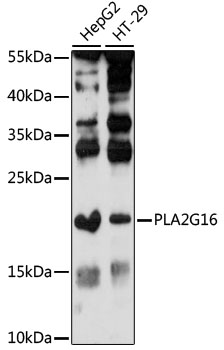-
Product Name
PLA2G16 Polyclonal Antibody
- Documents
-
Description
Polyclonal antibody to PLA2G16
-
Tested applications
WB
-
Species reactivity
Human
-
Alternative names
PLA2G16 antibody; AdPLA antibody; H-REV107 antibody; H-REV107-1 antibody; HRASLS3 antibody; HREV107 antibody; HREV107-1 antibody; HREV107-3 antibody; HRSL3 antibody; HRAS-like suppressor 3 antibody
-
Isotype
Rabbit IgG
-
Preparation
Antigen: Recombinant fusion protein containing a sequence corresponding to amino acids 68-162 of human PLA2G16 (NP_009000.2).
-
Clonality
Polyclonal
-
Formulation
PBS with 0.02% sodium azide, 50% glycerol, pH7.3.
-
Storage instructions
Store at -20℃. Avoid freeze / thaw cycles.
-
Applications
WB 1:500 - 1:2000
-
Validations

Western blot - PLA2G16 Polyclonal Antibody
Western blot analysis of extracts of various cell lines, using PLA2G16 antibody at 1:1000 dilution.Secondary antibody: HRP Goat Anti-Rabbit IgG (H+L) at 1:10000 dilution.Lysates/proteins: 25ug per lane.Blocking buffer: 3% nonfat dry milk in TBST.Detection: ECL Enhanced Kit .Exposure time: 90s.
-
Background
Lipid-modifying enzyme that acts as major regulator of adipocyte lipolysis by catalyzing the release of fatty acids from phospholipids in adipose tissue. Shows phospholipase A1 and A2 activity, catalyzing the calcium-independent hydrolysis of acyl groups in various phosphatidylcholines (PC) and phosphatidylethanolamine (PE). For most substrates, phospholipase A1 activity is much higher than phospholipase A2 activity. Phospholipase activity causes decreased intracellular levels of ether-type lipids, affecting peroxisome metabolism (By similarity). May also have acyltransferase activity: catalyzes both N-acylation of phosphatidylethanolamine to form N-acyl-phosphatidylethanolamine and O-acylation of lyso-phosphatidylcholines to form phosphatidylcholines. The relevance of acyltransferase activity in vivo is however unclear and would require additional evidences. Also has weak lysophospholipase activity (By similarity).; (Microbial infection) Acts as a host factor for picornaviruses: required during early infection to promote viral genome release into the cytoplasm. May act as a cellular sensor of membrane damage at sites of virus entry, which relocalizes to sites of membrane rupture upon virus unfection. Facilitates safe passage of the RNA away from LGALS8, enabling viral genome translation by host ribosome. May also be involved in initiating pore formation, increasing pore size or in maintaining pores for genome delivery. The lipid-modifying enzyme activity is required for this process.
Related Products / Services
Please note: All products are "FOR RESEARCH USE ONLY AND ARE NOT INTENDED FOR DIAGNOSTIC OR THERAPEUTIC USE"
